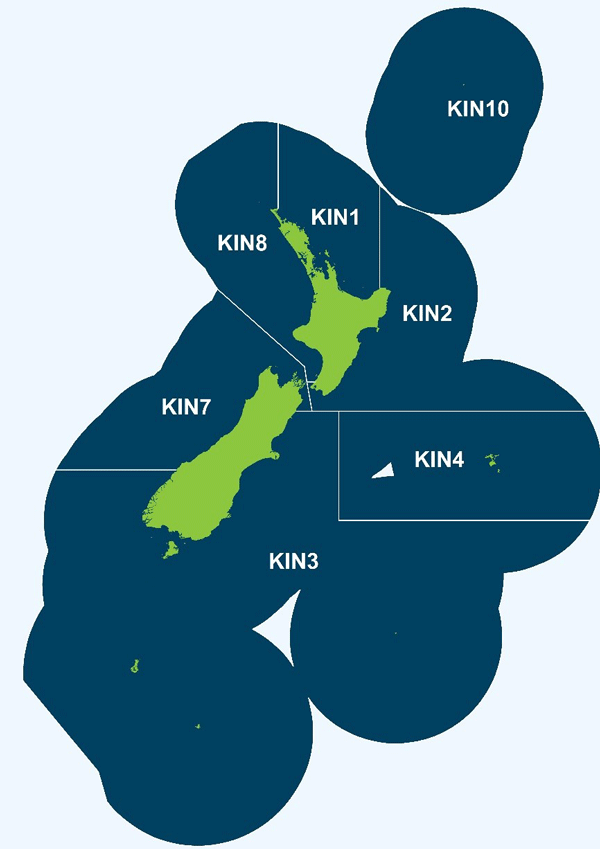
About kingfish
Māori names: kahu, haku
Scientific name: Seriola lalandi lalandi
Kingfish are green on top with a white underside and a green-gold band along their side. About 75% of all kingfish caught in New Zealand are caught by recreational fishers.
Kingfish are:
- most common in the northern half of the North Island but are found from the Kermadec Islands to Foveaux Strait
- found in open coastal waters, preferring high currents or tidal flows near rocky outcrops, reefs, and pinnacles
- sometimes found in areas with an open sandy bottom and in shallow, enclosed bays.
Kingfish are large predator fish. Adults grow to over 1.5m in length. They usually live in schools ranging from a few fish to well over 100. Recreationally caught kingfish average 10kg, but can be more than 30kg.
Fishing rules for kingfish
Fishing rules for kingfish (and other fish species) are different around the country and can change. Check the rules for your area every time before you go fishing.
Find the fishing rules for your area
Kingfish status and how we manage their numbers
To manage kingfish, we divide the ocean where they're found into 7 fishery management areas. Each area has a different limit on how many can be caught. The limits change depending on how healthy the fish numbers are, and what effects fishing is having on them.

2016 catch allowances (tonnes)
Kingfish are managed under New Zealand's Quota Management System (QMS). By controlling the amount of fish taken from each area, the QMS helps keep fisheries sustainable.
The QMS sets a yearly catch limit (total allowable catch) for kingfish in each area. From the total allowable catch (in tonnes), an allowance is made for recreational and customary fishing, and other fishing-related deaths. The number of tonnes remaining are what commercial fishers can catch.
What the allowances were for each group in 2016
|
Area |
Total allowance |
Commercial allowance |
Customary allowance |
Recreational allowance |
Other mortality¹ |
|---|---|---|---|---|---|
|
KIN 1 |
673 |
91 |
76 |
459 |
47 |
|
KIN 2 |
170 |
63 |
18 |
65 |
24 |
|
KIN 3 |
3 |
1 |
1 |
1 |
0 |
|
KIN 4 |
3 |
1 |
1 |
1 |
0 |
|
KIN 7 |
41 |
15 |
2 |
20 |
4 |
|
KIN 8 |
92 |
45 |
9 |
31 |
7 |
|
KIN 10 |
2 |
1 |
0 |
1 |
0 |
¹Fishing-related mortality from all sectors such as discarding and poaching.
Status of kingfish in the KIN 1 fishing area
| Area | Status1 | |
|---|---|---|
| Bay of Plenty | Inshore | At or below target (overfishing unlikely) |
| Offshore | At or below target (overfishing unlikely) | |
| East Northland/Hauraki Gulf | Inshore | Above target (overfishing likely) |
| Offshore | At or below target (overfishing unlikely) | |
12016 estimate based on total mortality compared to target mortality
This table shows stock status of KIN 1 – the largest kingfish fishery management area (by number of kingfish caught). Stock is assessed by comparing total mortality (from catch data) to a target mortality level. We're managing numbers to keep them at around 40% of the original number before modern fishing started in New Zealand. Status "at or below target" means mortality is low enough to keep the fish population safe. When the fish numbers are at or above this level, it's enough to keep them safely sustainable.
Find out more
For more information and data on kingfish in New Zealand, download the latest:
Report poaching
You can report poaching, suspicious, or illegal activity online:
Report illegal fishing (such as poaching)
You can also:
- call 0800 4 POACHER (0800 47 62 24), or
- email poacher@mpi.govt.nz
You can help us by providing:
- the location
- vehicle/trailer registration number
- boat name
- description of the person
When reporting any suspected poaching put your personal safety first. All calls and personal details are treated as confidential.
Who to contact
If you have questions about kingfish, email info@mpi.govt.nz








